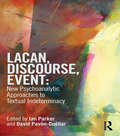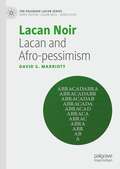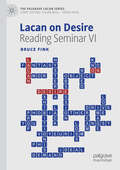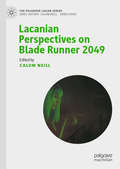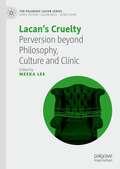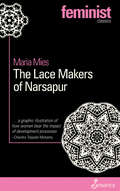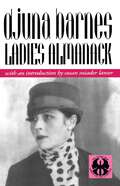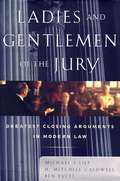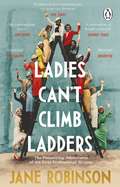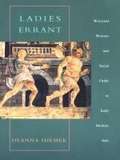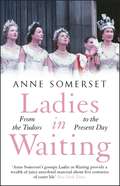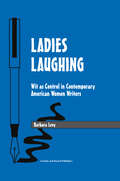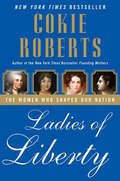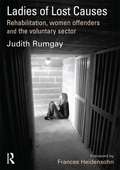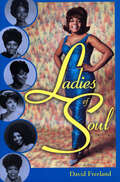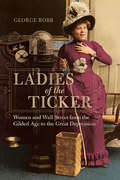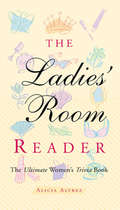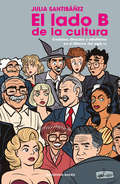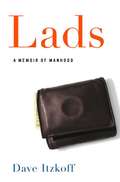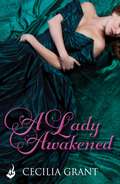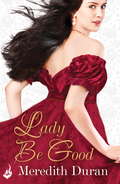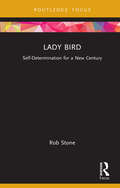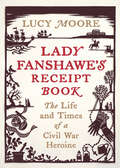- Table View
- List View
Lacan, Discourse, Event: New Psychoanalytic Approaches To Textual Indeterminacy
by Ian Parker David Pavón-CuéllarLacan, Discourse, Event: New Psychoanalytic Approaches to Textual Indeterminacy is an introduction to the emerging field of Lacanian Discourse Analysis. It includes key papers that lay the foundations for this research, and worked examples from analysts working with a range of different texts. The editors Ian Parker and David Pavón-Cuéllar begin with an introduction which reviews the key themes in discourse analysis and the problems faced by researchers in that field of work including an overview of the development of discourse analysis in different disciplines (psychology, sociology, cultural studies and political and social theory). They also set out the conceptual and methodological principles of Lacan's work insofar as it applies to the field of discourse. Ian Parker and David Pavón-Cuéllar have divided the book into three main sections. The first section comprises previously published papers, some not yet available in English, which set out the foundations for 'Lacanian Discourse Analysis'. The chapters establish the first lines of research, and illustrate how Lacanian psychoanalysis is transformed into a distinctive approach to interpreting text when it is taken out of the clinical domain. The second and third parts of the book comprise commissioned papers in which leading researchers from across the social sciences, from the English-speaking world and from continental Europe and Latin America, show how Lacanian Discourse Analysis works in practice. Lacan, Discourse, Event: New Psychoanalytic Approaches to Textual Indeterminacy is intended to be a definitive volume bringing together writing from the leaders in the field of Lacanian Discourse Analysis working in the English-speaking world and in countries where Lacanian psychoanalysis is part of mainstream clinical practice and social theory. It will be of particular interest to psychoanalysts of different traditions, to post-graduate and undergraduate researchers in psycho-social studies, cultural studies, sociology and social anthropology.
Lacan Noir: Lacan and Afro-pessimism (The Palgrave Lacan Series)
by David S MarriottThis book explores how Jacques Lacan has influenced Black Studies from the 1950s to the present day, and in turn how a Black Studies framework challenges the topographies of Lacanianism in its understanding of race. David Marriott examines how a contemporary Black Studies perspective might respond to the psychoanalysis of race by taking advantage of the recent revitalization of Lacanianism in its speculative, metaphysical form. While the philosophical side of the debate makes a plea for a new universalism, this book proposes a Lacanian reassessment of the notion of race, a notion distinct from culture, language, religion, and identity. It argues that it is possible to re-establish the theoretical relation between capitalism, anti-blackness, and colonialism, by reassessing the links between Lacanian psychoanalysis and three main domains of black inquiry: mastery, knowledge, and embodiment. The book offers a strikingly original rereading of the place of Lacan in both Fanon Studies and Afro-pessimism. It will appeal to students and scholars of Black Studies, Cultural Studies, Critical Theory and Philosophy.
Lacan on Desire: Reading Seminar VI (The Palgrave Lacan Series)
by Bruce FinkThis companion to Lacan’s Seminar VI guides readers through an examination of desire, fantasy, dream interpretation, death, object a, and the signifier of the lack in the Other as they are elaborated by Lacan. Bruce Fink draws on his extensive experience as a practicing analyst and as a leading translator of Lacan’s work (including Seminar VI), in this highly accessible exploration which includes both close textual analysis and illustrative clinical vignettes. Seminar VI, Desire and Its Interpretation, and Fink’s discussion of it here constitute a timely intervention for clinicians, for whom an engagement with desire is pivotal to the direction of the treatment, and for students and scholars interested in philosophy, sociology, anthropology, comparative literature, art, film, and social and political theory, for whom desire, fantasy, and object a may be useful conceptual tools. Combining rigorous analysis and a clear writing style, this guide provides an invaluable new resource.
Lacanian Perspectives on Blade Runner 2049 (The Palgrave Lacan Series)
by Calum NeillThis book provides a collection of Lacanian responses to Denis Villeneuve’s Blade Runner 2049 from leading theorists in the field. Like Ridley Scott’s original Blade Runner film, its sequel is now poised to provoke philosophical and psychoanalytic arguments, and to provide illustrations and inspiration for questions of being and the self, for belief and knowledge, the human and the post-human, amongst others. This volume forms the vanguard of responses from a Lacanian perspective, satisfying the hunger to extend the theoretical considerations of the first film in the various new directions the second film invites. Here, the contributors revisit the implications of the human-replicant relationship but move beyond this to consider issues of ideology, politics, and spectatorship. This exciting collection will appeal to an educated film going public, in addition to students and scholars of Lacanian psychoanalysis, psychoanalytic theory, cultural studies, film theory, philosophy and applied psychoanalysis.
Lacan’s Cruelty: Perversion beyond Philosophy, Culture and Clinic (The Palgrave Lacan Series)
by Meera LeeThis collection, written by leading Lacanian psychoanalytic theorists and practitioners, is a unique exploration of the novel aspects of perversion from the perspective of cruelty—a psychoanalytic study that has never been sufficiently undertaken in an English-speaking world. Instead of reducing the notion of perversion to cultural representations, a historical discourse or a clinical diagnosis, the authors in this collection draw on Freud, Kant, Hegel, Marquis de Sade, Derrida, Deleuze and Žižek to untie the knot of “psychic cruelty” intrinsic to perversion and therefore “de-sexualize” perverted acts. They do so by theorizing perversion in psychoanalytic concepts of the Oedipus complex, the-Name-of-the-Father and jouissance, and furthermore in the perspective of the clinics of neurosis and psychosis, in dialogue with a clinical praxis, philosophy and literature.
The Lace Makers of Narsapur
by Maria MiesA sensitive and groundbreaking study of women, this examination of globalization in India provides a fascinating case study of its effects on female workers in the state of Andhra Pradesh. Originally published in 1982, the book is an important insight into a group dispossessed before the recent economic boom in India. It details the way in which women have been used to produce luxury goods for the Western market while they are not counted as workers or producers in their fragmented workplaces. Instead, these women are defined as nonworking housewives and their work as leisure activity. With rates of pay far below acceptable levels, pauperization is accelerated and their position in Indian society rapidly deteriorates. An invaluable analysis with implications on the global stage, the case of the lace makers continues to instruct on the real impact of industrial development.
Lactivism: How Feminists and Fundamentalists, Hippies and Yuppies, and Physicians and Politicians Made Breastfeeding Big Business and Bad Policy
by Courtney JungIs breast really best? Breastfeeding is widely assumed to be the healthiest choice, yet growing evidence suggests that its benefits have been greatly exaggerated. New moms are pressured by doctors, health officials, and friends to avoid the bottle at all costs--often at the expense of their jobs, their pocketbooks, and their well-being. In Lactivism, political scientist Courtney Jung offers the most deeply researched and far-reaching critique of breastfeeding advocacy to date. Drawing on her own experience as a devoted mother who breastfed her two children and her expertise as a social scientist, Jung investigates the benefits of breastfeeding and asks why so many people across the political spectrum are passionately invested in promoting it, even as its health benefits have been persuasively challenged. What emerges is an eye-opening story about class and race in America, the big business of breastfeeding, and the fraught politics of contemporary motherhood.
Ladies Almanack (The Cutting Edge: Lesbian Life and Literature Series)
by Djuna Barnes"Lesbianism, its flories and sorows, is the subject and quest of this marvelously erverse sentimental journey by Nightwood's author... A striking lesbian mainfesto and a deft parody."-Library JournalBlending fiction, myth, and revisionary parody and accompanied by the author's delightful illustrations, Ladies Almanac is also a brilliant modernist composition and arguably the most audacious lesbian text of its time. While the book pokes fun at the wealthy expatriates who were Barnes' literary contemporaries and remains controversial today, it seems to have delighted its cast of characters, which was also the first audience. Barney herself subsidized its private publication in 1928. Fifty of the 1050 copies of the first edition were hand colored by the author, who was identified only as a lady of Fashion: on the title page.
Ladies And Gentlemen Of The Jury: Greatest Closing Arguments
by Michael S. Lief Ben Bycell Mitchell CaldwellIn the hands of a skilled trial lawyer, the closing argument offers the courtroom's greatest dramatic possiblilities. It is the advocate's last opportunity to convince the jury of their version of the "truth" before the defendent's fate is sealed. Every argument included here is a finely crafted verbal work of art - they represent the modern-day, highest form of an ancient profession and art: that of the storyteller. The only available collection of great closing arguments - complete with insightful analysis and biographical profiles of the lawyers involved - this fascinating volume gathers the passionate finales of the most celebrated cases in history. Included are the climactic closes to the Nuremberg War Trials; Gerry Spence's crusade against the Kerr-McGee Nuclear Power Plant after the mysterious death of Karen Silkwood; Vincent Bugliosi's successful prosecution of cult leader Charles Manson and his followers; the astounding acquittal of John Delorean despite video evidence of his offences and the prosecution resulting from the Mai Lai massacre.
Ladies Can’t Climb Ladders: The Pioneering Adventures of the First Professional Women
by Jane RobinsonIt is a myth that either of the World Wars liberated women.The Sex Disqualification (Removal) Act of 1919 was one of the most significant pieces of legislation in modern Britain. It marked at once political watershed and a social revolution; the point at which women of 21 and over were recognised in law as being as competent as men. But were they? What actually happened when this bill was passed? This is the story of what happened next.Ladies Can't Climb Ladders focuses on the lives of six women - six pioneers - forging paths in the fields of medicine, law, academia, architecture, engineering and the church. Robinson's startling study into the public and private lives of these women sheds light not on the desires and ambitions of her subjects but how family and society responded to the working woman and what their legacy looks like today. This book is written in their honour. It is a book about live subjects: equal opportunity, the gender pay gap, and whether women can expect, or indeed deserve, to have it at all.'An important and crackingly good read.' - Telegraph
Ladies Errant: Wayward Women and Social Order in Early Modern Italy
by Deanna ShemekThe issue of a woman's place--and the possibility that she might stray from it--was one of early modern Italy's most persistent social concerns. Ladies Errant takes as its starting point the vast literature of this era devoted to the proper conduct and education of women. Deanna Shemek uses this foundation to present the problem of wayward feminine behavior as it was perceived to threaten male identity and social order in the artistic and intellectual articulations of the Italian Renaissance.Seeing errancy as an act of resistance rather than of error, Shemek carries her study beyond the didactic and prescriptive literature on femininity in early modern Italy to an arena in which theories about femininity are considered jointly with real and fictional instances of women's waywardness. As prostitutes, warriors, lovers, and poets, the women of Shemek's study are found in canonical texts, marginal works, and popular artistic activity, appearing, for instance, in literature, paintings, legal proceedings, and accounts of public festivals. By juxtaposing these varied places of errancy--from Ariosto's chivalric Orlando furioso to the prostitutes' race in the Palio di San Giorgio--Shemek points to the important contact between elite and popular cultures in early modernity, revealing the strength and flexibility of a gender boundary fundamental to early modern conceptions of social order.
Ladies in Waiting: a history of court life from the Tudors to the present day
by Anne Somerset'Provides a wealth of juicy anecdotal material about five centuries of court life' New York Times'Naughty Knickers version of our island story' Daily Mail---------------------------------------------Ladies in Waiting chronicles the lives of famous and infamous ladies who served royalty, casting a fresh, intimate angle on four hundred years of monarchy. For centuries, the most beautiful, able and aristocratic women in England competed for positions at court. Some who came to serve were remarkable for their learning and exemplary virtue, but others were notable for promiscuity and lack of scruple, drawn to court by a lust for money and power. Several ladies-in-waiting became royal mistresses, showing few qualms about betraying the queen consorts they ostensibly served. If bedding the King was not an option open to all, many ladies came to court in hope of finding husbands, only to succumb to constant assaults on their virtue or to find themselves denied permission by their sovereign to marry. Drawing on an enormous variety of sources, Anne Somerset provides an illuminating guide to the character, profligate or pious, of each court. Contained within the stories of the individual women is a consistently entertaining commentary on the manners, morals and shifting mentality of the royal, the rich, and the prominent throughout the centuries, resulting in social history at its most enjoyable and vibrant.
Ladies in Waiting: a history of court life from the Tudors to the present day
by Anne Somerset'Provides a wealth of juicy anecdotal material about five centuries of court life'New York Times'Naughty Knickers version of our island story' Daily Mail---------------------------------------------Ladies in Waiting chronicles the lives of famous and infamous ladies who served royalty, casting a fresh, intimate angle on four hundred years of monarchy. For centuries, the most beautiful, able and aristocratic women in England competed for positions at court. Some who came to serve were remarkable for their learning and exemplary virtue, but others were notable for promiscuity and lack of scruple, drawn to court by a lust for money and power. Several ladies-in-waiting became royal mistresses, showing few qualms about betraying the queen consorts they ostensibly served. If bedding the King was not an option open to all, many ladies came to court in hope of finding husbands, only to succumb to constant assaults on their virtue or to find themselves denied permission by their sovereign to marry. Drawing on an enormous variety of sources, Anne Somerset provides an illuminating guide to the character, profligate or pious, of each court. Contained within the stories of the individual women is a consistently entertaining commentary on the manners, morals and shifting mentality of the royal, the rich, and the prominent throughout the centuries, resulting in social history at its most enjoyable and vibrant.
Ladies Laughing: Wit as Control in Contemporary American Women Writers (Studies In Humor And Gender Ser. #Vol. 3)
by Barbara LevyThis engaging and accessible book examines the world of seven contemporary, popular American women writers and their individual use of wit as a subtle and effective strategy to engage, or "control", the reader. A chapter is devoted to each of the seven writers - Lisa Alther, Rita Mae Brown, Nora Ephron, Shirley Jackson, Alison Lurier, Grace Paley, and Anne Tyler - and discusses their writings and their use of wit in the context of their lives. An opening chapter frames wit and control in psychological realities, and a concluding chapter summarizes the power of wit. A bibliography of the writers' works is also included, making this an ideal introduction and companion to these writers and their works.
Ladies of Liberty: The Women Who Shaped Our Nation
by Cokie RobertsIn Founding Mothers, Cokie Roberts paid homage to the heroic women whose patriotism and sacrifice helped create a new nation. Now the number one New York Times bestselling author and renowned political commentator-praised in USA Today as a "custodian of time-honored values"-continues the story of early America's influential women with Ladies of Liberty. In her "delightfully intimate and confiding" style (Publishers Weekly), Roberts presents a colorful blend of biographical portraits and behind-the-scenes vignettes chronicling women's public roles and private responsibilities. Recounted with the insight and humor of an expert storyteller and drawing on personal correspondence, private journals, and other primary sources-many of them previously unpublished-Roberts brings to life the extraordinary accomplishments of women who laid the groundwork for a better society. Almost every quotation here is written by a woman, to a woman, or about a woman. From first ladies to freethinkers, educators to explorers, this exceptional group includes Abigail Adams, Margaret Bayard Smith, Martha Jefferson, Dolley Madison, Elizabeth Monroe, Louisa Catherine Adams, Eliza Hamilton, Theodosia Burr, Rebecca Gratz, Louisa Livingston, Rosalie Calvert, Sacajawea, and others. In a much-needed addition to the shelves of Founding Father literature, Roberts sheds new light on the generation of heroines, reformers, and visionaries who helped shape our nation, giving these ladies of liberty the recognition they so greatly deserve.
Ladies of Lost Causes
by Judith RumgayIn this highly original study, Judith Rumgay evaluates the development of a residential programme for female offenders run by the Griffins Society. The text is unique in that it documents the radical contribution of women philanthropists and practitioners to offender rehabilitation. Drawing on archival, interview, and observational sources, the author describes, analyses, and evaluates a distinctive model of care provision by volunteer, upper-middle-class women that has since been overtaken by the professionalization of the voluntary sector. Rumgay illuminates the pathways of women into, and out of, serious crime; explores the dynamics of rehabilitative practice in the volatile setting of residential care; and also analyses the qualities of successful rehabilitative practice. Subsequently, the author suggests rehabilitative success is more appropriately understood within a paradigm of natural desistance from crime, instead of the more common appeal to a medical model of treatment. Moreover, this style of rehabilitative practice is inextricable from the broader social outlook of a dedicated group of philanthropic women, whose critics derided them with epithets such as 'Lady Bountiful'.
Ladies of Soul
by David FreelandAmerican soul music of the 1960s is one of the most creative and influential musical forms of the twentieth century. With its merging of gospel, R&B, country, and blues, soul music succeeded in crossing over from African American culture into the general pop culture. Soul became the byword for the styles, attitudes, and dreams of an entire era. Female performers were responsible for some of the most enduring and powerful contributions to the genre. All too frequently overlooked by the star-making critics, seven of these women are profiled in this book -Maxine Brown, Ruby Johnson, Denise LaSalle, Bettye LaVette, Barbara Mason, Carla Thomas, and Timi Yuro. Getting started during the heyday of soul, each of these talented women had recording contracts and gave live performances to appreciative audiences. Their careers can be tracked through the popularity of soul during the 1960s and its decline in the 1970s. With humor, candor, pride, and honest recognition that their careers did not surge into the mainstream and gain superstardom, they recount individual stories of how they struggled for success. Their oral histories as told to David Freeland address compelling issues, including racism and sexism within the music industry. They discuss their grueling hardships on the road, their conflicts with male managers, and the cutthroat competition in the recording business. As each singer examines her career with the author, she reveals the dreams, hopes, and desires on which she has built her professional life. All seven face up to the career swings, from the highs of releasing the first hit to the frustrating lows when the momentum stops. Although the obstacles to stardom are heartbreaking, these singers are committed to their art. With determination and style these seven have pressed onward with club appearances and recordings. They survive through their savvy mix of talent, hubris, and honesty about their lives and their music.
Ladies of the Ticker: Women and Wall Street from the Gilded Age to the Great Depression
by George RobbLong overlooked in histories of finance, women played an essential role in areas such as banking and the stock market during the late nineteenth and early twentieth centuries. Yet their presence sparked ongoing controversy. Hetty Green's golden touch brought her millions, but she outraged critics with her rejection of domesticity. Progressives like Victoria Woodhull, meanwhile, saw financial acumen as more important for women than the vote. George Robb's pioneering study sheds a light on the financial methods, accomplishments, and careers of three generations of women. Plumbing sources from stock brokers' ledgers to media coverage, Robb reveals the many ways women invested their capital while exploring their differing sources of information, approaches to finance, interactions with markets, and levels of expertise. He also rediscovers the forgotten women bankers, brokers, and speculators who blazed new trails--and sparked public outcries over women's unsuitability for the predatory rough-and-tumble of market capitalism. Entertaining and vivid with details, Ladies of the Ticker sheds light on the trailblazers who transformed Wall Street into a place for women's work.
The Ladies' Room Reader: The Ultimate Women's Trivia Book
by Alicia AlvrezFifty-seven percent of women would rather shop than have sex. Jodie Foster was born Ariane Munker, and Lauren Bacall, Betty Joan Perske. Oprah Winfrey and Margaret Avery, both nominated for Best Supporting Actress Oscars for The Color Purple, were the first two African-American women nominated in the same year for the same category. At the height of her popularity, screen star Betty Grable had her legs insured for,000 - a modest sum compared to the 0,000 policy Fred Astaire took out on his feet! These nuggets, along with everything else you've ever wanted to know about women, are to be found within this easy-to-browse resource. Here are women's views on shopping, clothing and cosmetics, marriage and children, food, sex, and pets, along with the lowdown on women celebrities and the feats of history's heroines and female adventurers.
El lado b de la cultura: Codazos, descaro y adulterio en el México del siglo XX
by Julia SantibáñezPasa, lectora, lector, estás en tu fiesta. Más que un libro, este objeto es un carnaval de cincuenta estaciones que desfila tras las bambalinas de la cultura mexicana. En él participan Tin Tan y Pita Amor, María Félix y Monsiváis, Piporro y Tongolele, Nahui Olin y Jorge Ibargüengoitia, los beats y Marilyn Monroe, Vitola y José Revueltas. Entre muchos, muchos otros. Mientras pasan, nos van contando de sus vicios, supersticiones, sus pleitos y apodos, los cuadrángulos amorosos que formaron y los cabarés que visitaron. Guiados por la insaciable curiosidad de Julia Santibáñez, nos enteramos de quiénes fueron huéspedes de Lecumberri y quiénes invitados a la casa de Carlos Fuentes; qué escritores la hicieron de actores y qué libros y películas gozaron de la mercadotecnia inversa de la censura y por qué. Encuentra aquí lo que los libros ceremoniosos nunca dirán sobre escritores, artistas e intelectuales.
Lads: A Memoir of Manhood
by Dave Itzkoff"What I wanted after college was a job and my own apartment, but what I needed was a good comeuppance, and that's what I got." When Dave Itzkoff graduated from Princeton in 1998--the first member of his family to earn a college degree--he expected to be rewarded with a career, and a life, that mattered. Instead, he ended up convinced that he was selling the entire institution of manhood down the river. After a series of personal and professional experiences stripped him of any lingering sense of entitlement, Itzkoff found himself working as an editor at Maxim, the pugnacious frontrunner in a new breed of men's periodicals dubbed "lad magazines." There, he was initiated into a culture of heavily retouched girlie pictorials, dirty jokes, disingenuous sex advice, and shopping guides for expensive electronic gadgetry. And as Maxim continued its inexorable rise to become the most successful men's magazine in modern publishing history, Itzkoff was left wondering what his work-and his life-really meant. Lads is the hilarious, heartbreaking story of Dave Itzkoff's efforts to define himself as a man while working at a magazine that was purveying a vision of young manhood-a state of perpetual adolescence-that was seductive to all but viable for none. Lads takes us deep inside one young man's struggle with identity, responsibility, and sexuality, in an unsparingly candid account of how men really relate to one another, as fathers and sons, as employers and employees, as colleagues and friends. Lads is trenchant. Lads is perceptive. Lads is alarmingly funny. This is an unforgettable debut from a young writer of astounding talent.
A Lady Awakened: Blackshear Family Book 1 (Blackshear Family)
by Cecilia GrantFans of Eloisa James, Sherry Thomas, Courtney Milan and Grace Burrowes will adore Cecilia Grant's emotionally rich and deeply passionate Regency romance.Newly widowed and desperate to protect her estate from her malevolent brother-in-law, Martha Russell conceives a daring plan. Or rather, a daring plan to conceive. If she has an heir on the way, her future will be secured. Forsaking all she knows of propriety, Martha approaches her neighbor, a London exile with a wicked reputation, and offers a strictly business proposition: a month of illicit interludes...for a fee. Theophilus Mirkwood ought to be insulted. But how can he resist this siren in widow's weeds, whose offer is simply too outrageously tempting to decline? Theo endeavors to awaken this shamefully neglected beauty to pleasure - only to find her dead set against taking any enjoyment in the scandalous bargain. Surely she can't resist him for ever. But could her surrender open their hearts to the most unexpected arrival of all...love?For more powerful, sensual romance, lose yourself in the Blackshear Family series: A Christmas Gone Perfectly Wrong, A Lady Awakened, A Gentleman Undone, A Woman Entangled.
Lady Be Good: Rules for the Reckless 3 (Rules for the Reckless #4)
by Meredith DuranMeredith Duran returns with another witty, humorous and smart romance in the third book of her Rules for the Reckless series. Fans of Julia Quinn, Jane Feather and Eloisa James will delight in Meredith's trademark headstrong heroine, cunning hero and tale of deep emotional intensity!Born to a family of notorious criminals, Lilah Marshall has long abandoned her past. A hostess at Everleigh's, London's premier auction house, she leads a virtuous life of art and culture. Lilah has almost transformed into the perfect lady - until an enigmatic viscount catches her in the act of one last, reluctant theft.Christian 'Kit' Stratton, Viscount Palmer, is society's most dashing war hero. But his charming façade masks a dark secret: he's haunted by a madman's vow to destroy anyone he loves. When Kit catches Lilah red-handed, he strikes a bargain she can't refuse. Their attraction is instant, but as their very lives hang in the balance, one tempting touch could be their undoing... Want more Rules for the Reckless? Don't miss That Scandalous Summer or Fool Me Twice.
Lady Bird: Self-Determination for a New Century (Cinema and Youth Cultures)
by Rob StoneExamining the ideas, philosophies, beliefs and fears that are expressed in Greta Gerwig's film, this is a detailed, insightful study of a much-loved, influential and critically-acclaimed film. Drawing on Transcendentalism, French feminist thought, Californian art and the work of iconic American essayist Joan Didion, Stone approaches Lady Bird as a film about young women’s self-determination in relation to other women and waves of feminist history and praxis. Structured to emulate the evolving conscience and emerging consciousness of the film’s eponymous protagonist, this new volume in the Cinema and Youth Cultures series provides an incisive portrait of a particular American youth subculture struggling to assert its identity between the shock of 9/11 in 2001 and the global financial crisis of 2008. Furthermore, it sensitively examines tensions between Gerwig and Lady Bird, and between Lady Bird being set in 2002 and made in 2017. Written by an expert on American independent cinema and the dynamics of World Cinema, this volume raises questions of self-determination that start with the tensions between mothers and daughters and culminate in considerations of how the film’s form and aesthetics lead to reflections on its philosophy and politics. Situating Lady Bird in the genre of youth movies and feminist film practice and culture, this book is ideal for students and researchers looking at wider dialogues and discourses about feminism, philosophy, gender, genre and independent filmmaking.
Lady Fanshawe's Receipt Book: The Life and Times of a Civil War Heroine
by Lucy MooreIn the mid seventeenth century, England was divided by war and bloodshed. Torn apart by rival factions, father opposed son and brother met brother on the battlefield. But while civil war raged on cobbled streets and green fields, inside the home domestic life continued as it always had done. For Ann Fanshawe and her children it meant a life of insecurity and constant jeopardy as she and her husband, a Royalist diplomat, dedicated their lives to the restoration of the Stuart monarchy. In this uncertain world, Ann's 'receipt book' was a treasured and entirely feminine response to the upheavals of war. These books were a feature of women's lives during this period, when there were few doctors to be found, and were full of life-saving medical knowledge that had been gleaned from mothers and friends. Remarkably, Ann's morocco-bound book full of scraps of ink-stained paper has survived to this day.Using Ann's receipt book and the memoirs she wrote for her surviving son, Lucy Moore follows her through this turbulent time as she leaves home, marries, bears - and buries - children and seeks to hold her family together. Lady Fanshawe's Receipt Book brilliantly brings to life Ann's struggles and her joys, revealing how ordinary women across the country fought to protect their loved ones in the face of conflict.
